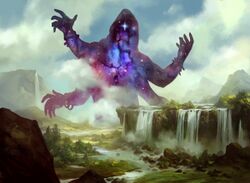Kruphix
| Kruphix | |
|---|---|
| God of the Horizon | |
| Information | |
| Colors |
|
| Species | God |
| Birth, Life & Death | |
| Birthplace | Theros |

Kruphix (/krufɪks/, KROO-fihks[1]) is the god of horizons, mysteries, and the passage of time on Theros. He governs the unseen and unknown, holding dominion over potential, navigation, and the cycles of time. Kruphix is associated with blue and green mana and is considered the eldest of the gods, existing before mortal belief gave form to the younger gods. Unlike most deities, he speaks rarely and often appears only as a star-filled silhouette, symbolizing his abstract and enigmatic nature. His followers include scholars, sages, and mystically inclined sailors who seek hidden knowledge and guidance.
Description
Kruphix is the oldest god alongside Klothys and is uniquely tied to everything unseen or unknown.[2][3] His true form is an abstract, hooded, four-armed silhouette filled with stars, sometimes resembling a bird or whale. Two bright stars often mark the position of his eyes. He speaks seldom, usually in barely audible whispers, but can project a powerful voice directly into the minds of all gods when the cosmic order is at risk.
Kruphix controls the horizon—the boundary between the known and the unknown—and holds the secrets of past, present, and potential knowledge. He alone decides which mysteries mortals may learn and which must remain hidden. He is the only being capable of sealing the borders between the mortal realm and Nyx, safeguarding the balance of power among the gods, and preventing reckless divine interference.
Due to his reclusive nature and few worshippers, many mortals consider him a minor or obscure deity, but other gods regard him with respect and caution. His temple stands over a cataract at the edge of the world, where his oracle, Kydele, serves as his primary communicator with mortals.
Influence and Goals
Kruphix holds sway over the unknown, mysteries, and navigation. He views perfect understanding like the horizon—always approachable but never fully reachable. He seeks only to oversee the acquisition of knowledge, maintain the flow of time, and preserve divine balance. Unlike younger gods, he does not seek power for its own sake and instead mediates disputes between gods to prevent excesses.
He is wary of Heliod, whom he sees as arrogant and a threat to the pantheon’s balance, and prefers subtle opposition over direct conflict. Kruphix respects the death gods Erebos and Athreos for their roles in the cosmic cycle, though he blames Erebos for Klothys's unexpected emergence from the Underworld.
Kruphix’s only true concern is Klothys, the other eldest god, whose recent return he neither understands nor controls. He avoids provoking her but watches cautiously for how her presence will affect the divine order.
Worship
Kruphix’s followers are few and secretive, often scholars, sages, and sailors who seek lost or hidden knowledge. Cults dedicated to him guard their secrets closely and avoid drawing attention. Some followers travel in secret, using signals to find safe refuge with other worshippers.
Rituals in his honor take place at natural boundaries such as shorelines, riverbanks, equinoxes, and sunsets. One major festival is the Agrypnion ("the Watching"), which marks the end of winter and the close of the year, emphasizing reflection and the passage of time.
History
Before the rise of Xenagos, Kruphix declared the Silence of the Gods, a period during which gods ceased interfering directly in mortal affairs to restore balance after chaos in Nyx. He and his oracle observed the defeat of Xenagos by Elspeth and Ajani, as well as Elspeth's later betrayal by Heliod.
Kruphix revealed that the gods of Theros arose from mortal belief, shaping the fabric of Nyx. Even he, the eldest, does not predate mortal belief. Gods initially emerged from concrete domains such as death, the sun, and the sea, and later from abstract domains like war and deception. Though domains remain constant, the gods themselves evolve; for example, Heliod was not always the sun god, but mortals' perception retroactively established him as such.
Kruphix himself does not know why the gods exist and prefers not to seek the answer. He is troubled by the fears of planeswalkers Elspeth, Ajani, and Kiora. They have witnessed cataclysms beyond his realm: the Eldrazi devouring worlds, the schemes of Nicol Bolas, and the corruption of New Phyrexia. He fears these threats could doom Theros if they set their sights on it.
His fears proved justified when New Phyrexia invaded the multiverse, targeting several planes, including Theros. Though the invasion was ultimately repelled, it remains unknown if Kruphix was compleated during this crisis.
Inspiration
The character of Kruphix seems to have multiple inspirations.
- One is Terminus, Roman god of frontiers. Legend has it that Terminus was the only god who did not give way to Jupiter when he moved into his temple on the Capitol.
- Other is Janus, the Roman god of beginnings, gates, transitions, time, duality, doorways, passages, frames, and endings.
- Kruphix is also described as a god of the dawn, making him at least vaguely analogous to Eos.
- Finally, Kruphix resembles several Greek primordial deities, including Uranus, Aether and Chronos (not the titan father of Zeus), who were also sky gods and were also among the first gods in existence.
Gallery
Story appearances
In-game references
- Represented in:
- Associated cards:
- Depicted in:
- Quoted or referred to:
References
- ↑ Wizards of the Coast (September 26, 2013). "Theran Pronunciation Quiz". magicthegathering.com. Wizards of the Coast. Archived from the original on 2021-04-30.
- ↑ Kelly Digges (June 11, 2014). "Kruphix's Insight". magicthegathering.com. Wizards of the Coast.
- ↑ Wizards RPG Team (2020), D&D Mythic Odysseys of Theros, Wizards of the Coast
External links
- The Magic Creative Team (April 02, 2014). "Planeswalker's Guide to Journey into Nyx". magicthegathering.com. Wizards of the Coast. Archived from the original on 2020-11-12.

